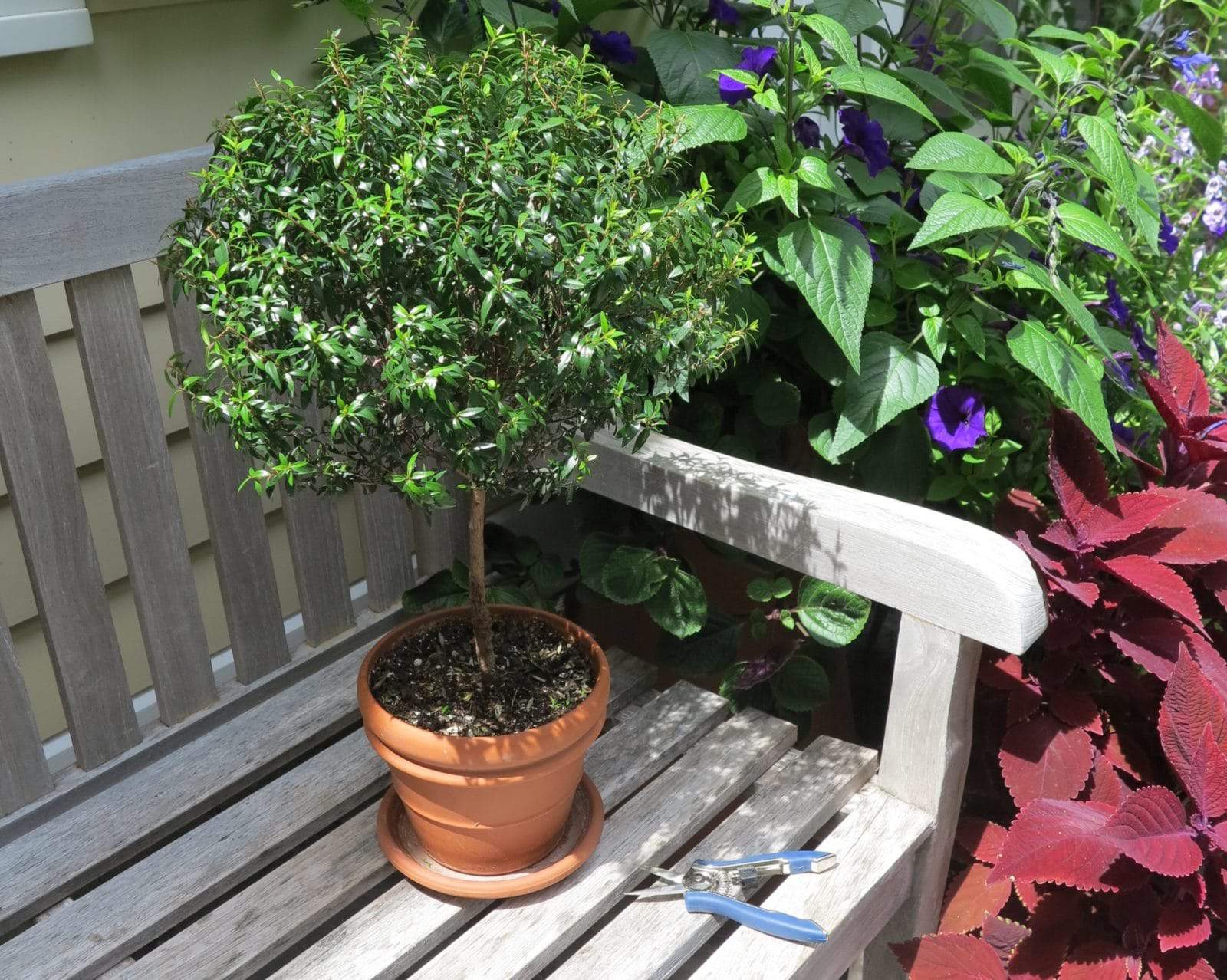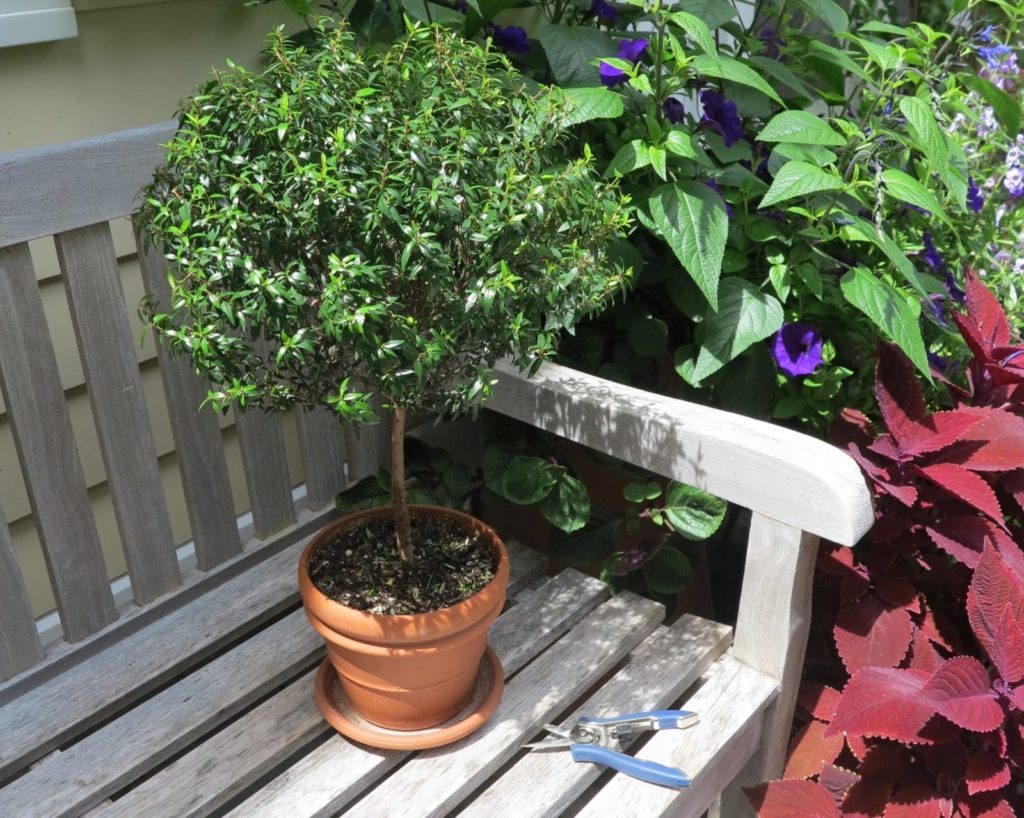
A touch of formality is not out of place in most gardens, and precisely trimmed cones and spheres of foliage — classic forms of topiary — are especially suited to containers. All that’s required is a beautiful container, a plant amenable to frequent pruning and patience.
There are myriad ways to incorporate a potted topiary into your landscape. Try an elegant container with a herb topiary such as rosemary or bay as a focal point in a collection of potted herbs near a back door. A large, classic urn with a dramatic coleus topiary flanking a front door offers an elegant welcome; two identical specimens standing sentry on either side are especially suitable for a formal, symmetrical façade. Topiaries in sleek metal containers or minimalistic concrete pots complement contemporary-style gardens.
Choosing a container
Select a container that complements the backdrop of where it will be sited as well as the plant specimen. Topiaries are classic and elegant and look best in containers with these attributes. Proportion is also important for the overall effect, and generally the size of the container should be similar in size to the mature head of the topiary’s foliage.
Whatever the material or style, the container must have a drainage hole (don’t cover the hole with gravel or pot shards; let it drain freely). If there’s no drainage hole and one can’t be drilled without risking damage, use it as a cachepot and plant the topiary in a plastic grow pot that fits inside. Empty the water that collects in the cachepot after watering.
Training tips
- Choose a plant with a straight central leader. It’s fine to start with a young plant and gradually grow it on to maturity. Transplant it into incrementally larger pots as it grows larger and taller.
- Insert a slim bamboo stake into the soil near the central stem. (A narrow stake is kinder to the root ball.) The top of the stake should reach the bottom of the (ultimate) head of foliage. With soft twine, use a figure-eight tie to secure the stem to the stake.
- Clip off all side branches from the base of the plant to the point where you want the bottom of the head of foliage to begin. To promote new branches to sprout at the top, remove about an inch (2.5 cm) from the tip of the central leader. If you’re starting with a small plant without a lot of foliage, don’t remove all the side branches at once; do this in stages over a few weeks — pruning too much foliage at once stresses a young plant.
- Once you have the rough outline of your topiary, wait for new growth at the top before starting to shape the crown. Now begin lightly pruning branch tips on a regular basis to trigger more branching. When pruning, step back periodically and look at the plant from all angles. As with bad haircuts, a lopsided topiary will eventually grow in, but it requires time.
Long-term care
Pruning: To maintain a symmetrical shape and trigger denser branching, prune lightly but frequently during the growing season. Plants with large leaves, such as bay, sage and scented geranium, should be cut back to a leaf node. Those with small leaves, such as rosemary and lavender, can be lightly sheared.
Light: Follow the plant’s specific light requirements to promote vigorous, dense growth. Rotate the pot every few days to encourage uniform growth.
Feeding: Fertilize during active growth — spring and summer — every two weeks at half the recommended strength with a water-soluble fertilizer such as 10-15-10. Herbs need less frequent feeding.
Mulch: Use material such as terracotta beads, small shells, polished pebbles or gravel to help retain moisture and provide an attractive finishing touch. Keep mulch away from the stem of the plant.
Snippable choices
Small-leaved shrubby plants make the best candidates for topiary. The examples listed here, with the exception of boxwood, sage and lavender, are overwintered indoors in a sunny window in Zones 6 and colder. Boxwood, lavender and sage may be overwintered outdoors in large, protected containers.
Rosemary (Rosmarinus officinalis)
Sweet bay (Laurus nobilis)
Greek myrtle (Myrtus communis)
Coleus (Solenostemon cvs.)
Sage (Salvia officinalis)
Santolina (Santolina chamaecyparissus)
Boxwood (Buxus spp. and cvs.)
Germander (Teucrium fruticans)
Scented geranium (Pelargonium hybrids)
Lavender (Lavendula spp. and cvs.)
Did you know?
Dating from Roman times, topiary has waxed and waned in popularity over the course of garden history. In the Middle Ages, it was mainly practised in the enclosed gardens of monks and royalty. In Colonial New England, topiaries populated knot gardens.










Enjoyed your article, facts not fluff. I have had success with ivy grown up a metal stake into a sphere shaped cage. Not sure if this is topiary but looks like it. Now I want to try your method.